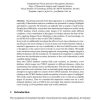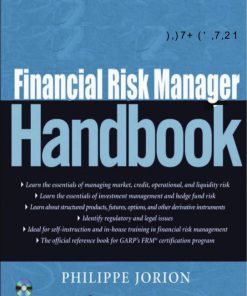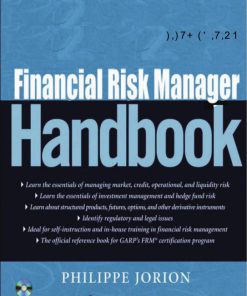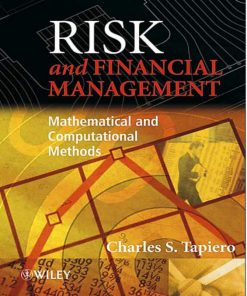Financial Strategies for the Manager 1st Edition by Charles Priester, Jincheng Wang 3540709630 9783540709633
$50.00 Original price was: $50.00.$25.00Current price is: $25.00.
Authors:Charles Priester, Jincheng Wang , Tags:Springer 2010 , Author sort:Charles Priester, Jincheng Wang , Ids:3540709630 , Languages:Languages:eng
Financial Strategies for the Manager 1st Edition by Charles Priester, Jincheng Wang – Ebook PDF Instant Download/Delivery. 3540709630, 9783540709633
Full download Financial Strategies for the Manager 1st Edition after payment
Product details:
ISBN 10: 3540709630
ISBN 13: 9783540709633
Author: Charles Priester, Jincheng Wang
Part of Tsinghua University Texts, Financial Strategies for the Manager includes a range of financial management issues such as financial statement analysis, a systematic approach to financial performance appraisal, liquidity management and sales growth, working capital management, budgeting, foreign exchange and interest rate risk management, and a most useful tool not normally understood – EVA. The book is written in a concise and accessible style, minimizing the use of the technical jargon and complicated mathematical formulae. Included exercises enhance student learning and examples bolster ability to understand and use concepts in day-to-day situations. The material was originally developed for a large corporate client in the telecommunications business to assist non-financial managers in understanding financial theories in a practical way. It was expanded and revised into a text for a post-graduate course of the Asia/Pacific Management Co-operative Program, Capilano University, BC, Canada. Charles Priester is a professor at Capilano University of Canada; Jincheng Wang is a professor at the International Business School of Tianjin Foreign Studies University of China.
Financial Strategies for the Manager 1st Table of contents:
1 Goals of Financial Management
1.1 Introduction
1.2 Getting More Mileage Out of a Company’s Assets
1.2.1 Important Observation
Maximizing Asset Productivity And Profitability
1.3 What Information Do the Financial Statements Convey to the Manager
1.3.1 A Close-Up of the Financial Statements
1.3.1.1 The Balance Sheet
1.3.1.2 Permanent vs. Temporary Accounts
1.3.2 An Important Observation about the Balance Sheet and the Income Statement
1.4 Income Statement
1.5 Flow of Funds Statement
1.5.1 Example of a Flow of Funds Statement
2 Financial Statements Analysis
2.1 Five Key Attributes of Performance
2.2 Liquidity
2.2.1 A Useful Analogy
2.3 The Broad Strategy of Managing a Company’s Operational Cash Flows
2.4 Analytical Framework for “Speeding up the Dollar Inflow”
2.5 Financial Leverage
2.6 Activity or Productivity of Assets
2.7 The Operating Cycle
2.8 Observations about the Operating Cycle and Payable Cycle
2.8.1 An Example
2.8.2 The Effect of this Strategy
2.8.3 Another Example
2.9 Profitability
2.10 The DuPont Approach to Performance Analysis
3 A Systematic Approach to Financial Performance Appraisal of a Company Based on Trend Analysis
3.1 Introduction
3.2 This Systematic Approach Involves Four Stages and Is Best Explained By Using an Example
3.2.1 Stage One
3.2.2 Stage Two
3.2.3 Stage Three
3.2.4 Stage Four
3.2.5 An Additional Analysis—Liquidity
3.2.6 Valuation Ratios
3.3 An Example of Ratio Calculations
4 Risk & Defensive Strategies
4.1 The Concept of Leverage in Business Finance
4.2 The Safety Ratio and a Company’s Break-Even Level
4.3 Defensive Strategies
4.3.1 Example of Defensive Strategy
4.4 An Example of a Systematic 4-stage Analysis of Case Study #10
4.4.1 Stage I
4.4.2 Stage II
4.4.3 Stage III
An Analysis of the Margins
4.4.4 Stage IV
4.4.5 Valuation Ratios
4.5 RR Distributors Analysis Continued
5 Liquidity Management and Sales Growth
5.1 Going Broke While Selling More Than Ever
5.1.1 Liquidity and Sales Growth—Is Rapid Growth in Sales Good News or Bad News
6 Working Capital Management
6.1 Introduction
6.2 Modern Communication Technology and the Smaller Company
6.3 Current Assets
6.4 Cash and Liquidity Management
6.4.1 First Current Asset, Operating Cash
6.4.2 Second Current Asset—Receivables
Receivables Management
6.4.3 Inventory Management
6.4.3.1 The Next Current Asset—Inventories
6.4.3.2 Role of Inventories
6.4.3.3 Dangers of Inventories Too Low
6.5 Business Intelligence—The Key Asset
6.5.1 Inventory Richness
6.6 Two Approaches in Measuring the Costs of Receivables and Inventories
6.7 Receivables Management—Introduction
6.7.1 Receivables Management
6.7.1.1 An Example of Receivable Costs
6.7.1.2 An Example of Improved Receivables Management
Cost/Benefit Analysis
6.7.2 Summary
6.8 Inventory Management
6.8.1 Introduction
6.8.2 Inventory Management
6.8.2.1 Financing Costs
6.8.2.2 Holding Costs
6.8.2.3 Transportation Costs
6.8.2.4 Summary
6.9 Operational Cash Management
6.9.1 Introduction
6.9.2 Global Distributing Example
6.9.2.1 Facts
6.9.2.2 Effect on Balance Sheet
6.9.2.3 Corrective Action
6.10 Fluctuating Short-Term Debt
6.11 Cash Management
6.11.1 Some Useful Questions to Ask
6.11.2 Accounts Payable Management
6.11.3 Summary
6.12 Investment Analysis
6.12.1 Introduction
6.12.2 Investment Analysis
6.12.2.1 First Approach
6.12.2.1.1 Scenario 1
6.12.2.1.2 Scenario 2
6.12.2.2 Second Approach
6.12.3 Summary
7 Fixed Assets
7.1 Capital Budgeting
7.1.1 Example of a Typical Capitalization of a Canadian Corporation
7.1.2 An Example of Spreadsheets Used for Capital Budgeting
7.1.2.1 Residual Values Also Enter This Equation
7.1.2.3 Some Broad Guidelines For Capital Budgeting
7.1.2.4 General Observation
7.2 The Analysis of “Financial Leasing”
7.2.1 Cash Flow Lease Analysis (Best Performed Using Spreadsheets as a Tool)
7.2.2 General Observation
8 Budgeting
8.1 Introduction
8.2 Less Common Financial Ratios for Use in Budget Design and Performance Appraisal
8.3 A Particular Type of Budgeting: Pro-Forma Statement Building
8.4 Example of Pro-Forma Statement Building Based on the 1998 Financial Statements of Electronic Dis
9 Economic Value Added
9.1 Using Economic Value Added (EVA) as a Strategic Evaluation Tool
9.2 A Fresh Look at the Balance Sheet
9.3 What About EVA Levels
9.4 To Calculate EVA We Need to Know the WACC%
9.5 The Debt/Equity Mix’s Effect on WACC%
9.6 Strategies to Raise EVA
9.7 Three Measures of Financial Performance
9.8 Financial Goal-Setting Using EVA
9.8.1 Calculating EVA
9.8.2 Conclusion
9.8.3 Approach One
9.8.4 Approach Two
9.8.5 Approach Three
9.8.6 Approach Four
9.9 Summary
9.10 Some Additional Thoughts about EVA-Enhancing Strategies
10 Foreign Exchange and Interest Rate Risk Management
10.1 Introduction
10.2 Foreign Exchange Risk Management Techniques
10.2.1 FX Forward Contracts
10.3 Foreign Currency Futures
10.3.1 FX Futures Contracts
10.4 Important Differences and Similarities Between FX Forward and FX Future Contracts
10.5 FX Options
10.6 Interest Rate Risk Management
11 Mergers, Acquisitions and Private Equity
11.1 Introduction
11.2 Synergy
11.2.1 Acquisition vs. Merger
11.2.2 Paying for the Purchase
11.2.3 Valuation
11.3 Which Companies are Doing Most of the Buying
11.4 Private Equity Firms Obtain Their Funding in Private Markets
11.4.1 Categories of Private Equity Investments Include
11.5 Will the Explosive Growth of Mergers and Acquisitions Activities Continue
11.6 How Long Can This Go On
Appendix A Solutions to Exercises
Appendix B Case Studies 1.15 (Solutions to Case Studies 1, 4 and 14)
Appendix C Glossary
People also search for Financial Strategies for the Manager 1st:
financial strategies for successful retirement
financial strategies advisory
financial strategies examples
financial strategies for retirement
You may also like…
eBook PDF
Financial Risk Manager Handbook 5th Edition by Philippe Jorion, GARP 0470479612 978-0470479612













